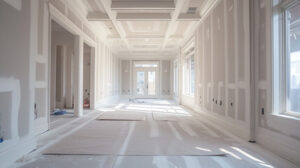A well-maintained deck adds to a home’s value while providing an outdoor space for family and friends. However, like any other structure, decks require repairs to stay safe and in good condition.
Begin by conducting a thorough inspection of the surface and substructure. Check for splintered wood, water damage, mildew and rotted boards or railing posts. Visit https://deckbuilderscharleston.com/ to learn more.

Wood rot, loose boards, cracks, and warping are common signs that it’s time for deck repair. Minor issues like tripping hazards and fading finishes can be easily repaired by sanding and staining, but significant problems may require replacement. If the deck is showing extensive wear and tear or if underlying damage is apparent, it’s often best to replace the entire deck to avoid serious safety hazards.
If you’re not sure whether your deck is beyond saving, ask a professional. Having an experienced contractor perform a thorough inspection can help you identify areas that are a risk and prioritize repairs. They can also work more quickly and efficiently than DIY enthusiasts, minimizing disruption to your daily routine.
Start by checking for soft or spongy areas of the deck’s surface, which indicate a possible rot problem. If the wood feels weak or gives way when you step on it, you should call a professional immediately. You can treat rot in early stages by using a fungicide and filling the affected area with epoxy. Once the area is dry, you can sand it down to smooth the surface. If the damaged board is soft and spongy all the way through, however, it’s best to replace it completely to prevent further damage.
Check for splinters and other areas of damage, such as stains from mildew and mold. Look at the condition of the support beams and posts, joists, ledger boards (the boards that connect your deck to the house), and hardware. These components are essential for ensuring that the deck is stable and safe for use, so they need to be in good shape.
Loose railings or wobbly stairs can pose a safety risk, so these should be fixed immediately. A sagging section of the deck or serious problems with the stairway may be cause for a complete replacement to ensure safety. Termite infestation is another indication that it’s time to rebuild the deck, as this type of damage can be impossible to fix and can compromise the structure of the deck.
Safety Hazards
A deck is a great place to entertain family and friends, but it can also be dangerous if it becomes damaged or unsafe. Inspecting your deck for issues like loose railings, sagging boards, and insect infestations on a regular basis will prevent these problems from becoming severe. If you spot a problem during a safety inspection, it is important to address it immediately before it gets out of hand.
Stairs and railings are key features that make a deck safe for walking, but they can become unstable over time due to age and normal wear and tear. If they aren’t repaired quickly, old stairs may collapse under your weight, which can be extremely dangerous to anyone who is using them. Loose railings are also a safety risk, as they can fall down easily and cause serious injuries. During an inspection, check each one for signs of looseness, including using slight hand pressure to test for movement. In addition, look for rust and corrosion on metal components.
Wood rot and moisture damage are common problems that can significantly weaken a deck’s structural integrity. Moisture can seep into wood and corrode connections or fasteners, causing them to loosen or fail. This type of damage can be avoided by using high-quality materials that are resistant to moisture, such as composite decking. It is also essential to properly position plants and shrubs away from the deck to reduce the amount of moisture that collects underneath it.
It’s also important to regularly inspect and repair decking boards and stairs for any sagging or warping. If you notice these issues, it’s important to replace them before they deteriorate further and pose a safety risk for your guests.
A professional engineer can help design a solution, assess the deck’s structural integrity, and ensure repairs are made according to code. They can also recommend upgrades to improve durability and longevity. For example, adding joist hangers or span braces can reinforce the deck’s frame and improve stability, while replacing older materials with new ones that are resistant to moisture. Investing in a professional maintenance plan will save you money and keep your deck looking great for years to come.
Cost
The cost of repairs or rebuilding your deck can vary depending on a few factors. First, there is the cost of materials. Different types of decking materials have different costs and maintenance needs. Wood decks are typically cheaper to repair than composite or PVC decks. The type of decking you choose will have a significant impact on the total cost of the project.
The condition of the deck’s substructure is also a factor. If there are major structural problems, such as rot or insect infestation, it could be more expensive to rebuild the entire deck than to simply replace damaged boards.
It’s a good idea to thoroughly examine the whole deck at least twice a year. Move any furniture or flowerpots and look at the surface and stairs from every angle. Look for loose or rotting board, sagging or crooked railings, and rusted hardware like joist hangers. You can also test the stability of the deck by pushing and wriggling the railings, stairs and handrails to see if they have any give or sway.
Loose railings are a safety concern, but they don’t necessarily indicate that the deck needs to be replaced. If the railings are unstable or sway under pressure, however, it’s important to consult with a professional right away to ensure the safety of everyone who uses the deck.
You should also consider the cost of refinishing or staining the deck after you make any necessary repairs. This will help protect your investment and prolong the life of your deck. The cost of refinishing can vary widely, but you can minimize your expenses by opting for low-VOC stains and choosing less expensive materials such as pressure-treated wood.
If you do decide to invest in a deck repair or rebuild, be sure to account for any permits required for the work. New construction usually requires a permit, but this can vary by city. Some repairs might require a permit as well, including those that involve the ledger board (the point where the deck attaches to the house). The cost of a permit can increase your overall budget.
Time to Replace
Wood decks typically have a lifespan of 10-15 years, so if your deck is getting up there in age, it may be time to start thinking about replacing it. If you’re planning on doing a replacement, composite or PVC materials tend to have much longer lifespans than wood and may be more cost-effective in the long run.
One of the biggest indicators that it’s time to replace a deck is any type of visible damage or rot. Rotting wood will only get worse over time and could eventually eat through the posts, beams or ledger boards that support the deck. It’s also a good idea to look for pest infestations like termites, carpenter ants or wood-boring beetles as these can cause damage from the inside. Look for signs of infestation, including small holes in the wood, a hollow sound when tapping on the deck and sawdust or other debris around the deck.
If you notice any of these issues, it’s important to call a professional for an inspection as soon as possible. A skilled and experienced deck-building professional can evaluate the damage and provide an honest assessment of whether it’s better to repair or replace the deck.
Loose railings, rotting boards and unstable stairs are all safety hazards that require immediate attention to avoid accidents or serious injuries. A contractor can usually tighten loose hardware or fix splintered boards within a day.
A cracked or splintered board may simply need to be replaced with a new board that seamlessly integrates with the existing boards. This is often a quick and easy repair, although it can be more expensive if you need to purchase a special wood.
Minor mold and mildew growth is another common issue that requires prompt attention to avoid further damage. While some greenish mold is normal, any mushroom-like growths or other fungi should be cleared immediately and treated with a fungicide to prevent further deterioration.
It’s not uncommon for other parts of the deck to need attention at the same time as the boards, such as a broken railing or rotting stairs. While these are less expensive than the deck boards themselves, they’re still a safety hazard and should be addressed promptly to prevent accidents or serious injuries.








